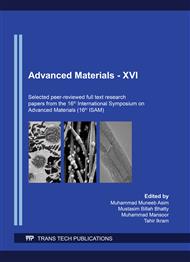[1]
W. M.Thomas, E. D. Nicholas, J. C. Neesham, M. G., Church Temple smith P.,Dawes C. J., Friction Stir Welding, International Patent Application No. PCT/GB92102203 and Great BritainPatent Application No. 9125978, TWI Ltd., Cambridge, UK, (1991).
Google Scholar
[2]
H. Uzun, C. D. Donne, A. Argagnotto, T. Ghidini, C. Gambaro, Friction stir welding of dissimilar Al 6013-T4 to X5CrNi18-10 stainless steel, Mater. & Des.,26 (2005)41-46.
DOI: 10.1016/j.matdes.2004.04.002
Google Scholar
[3]
M. Jafarzadegan, F. Kargar, T. Saeid, A. Abdollah-Zadeh, F. Malek, Effect of Friction Stir Welding parameters on the microstructures and mechanical properties of 304 Stainless Steels, Eng. of Metall.,30 (2009) 26-30.
Google Scholar
[4]
M. W. Mahoaney, C. G. Rhodes, J. G. Flintoff, R. A. Spurling, W. H. Bingel, Properties of friction-stir-welded 7075-T651 Aluminium, Metall. Mater. Trans. A, 29 (1998) 1955-1964.
DOI: 10.1007/s11661-998-0021-5
Google Scholar
[5]
C. Huang, S. Kou, Partially melted Aluminium welds liquation mechanisms and directional solidification, Welding Journal. 79 (2000) 113-120.
Google Scholar
[6]
R. S. Mishra, Z. Y. Ma, Friction Stir Processing Technology - A Review, Mater Sci. Eng. R, 50 (2005)1-78.
Google Scholar
[7]
B. Naga Sunil, B., Anudeep K. Tirupathi, Experimental study on the effect of welding speed and tool pin profiles on AA2014-T6 friction stir welded butt joints, Int. J. of Eng. Res. & Gen. Sci., Volume 3, Issue 1, January-February, 2015, ISSN 2091-2730.
DOI: 10.4314/ijest.v2i5.60163
Google Scholar
[8]
R. Kadaganchi, M. R.Gankidi, H.Gokhale, Optimization of process parameters of aluminum alloy AA 2014-T6 friction stir welds by response surface methodology, Def. Technol., 11 (2015) 209-219.
DOI: 10.1016/j.dt.2015.03.003
Google Scholar
[9]
B. Anudeep, K. Adepu, P.Naresh, Influence of shoulder interface geometry on microstructural and mechanical properties of 2014 Al alloy fabricated via friction stir welding, Int. J. Curr. Eng. & Technol., ISSN 2277-4106.
Google Scholar
[10]
G. Roudini, M. M. Rahvard,S. G. Shiri, Investigation the Maximum Traveling Speed of Friction Stir Welding (FSW) on Properties of 5052 Al Alloy, International Congress on Advances in Welding Science and Technology for Construction, Energy and Transportation Systems (AWST - 2011) 24-25 October 2011, Antalya, Turkey.
DOI: 10.4028/www.scientific.net/amm.110-116.3165
Google Scholar
[11]
D. Avula, V. Devuri, M. Cheepu, D. K. Dwivedi, Tensile Properties of Friction Stir Welded Joints of AA 2014-T6 Alloy at Different Welding Speeds, IOP Conf. Series: Mater. Sci. and Eng., 330 (2018) 012-081.
DOI: 10.1088/1757-899x/330/1/012081
Google Scholar
[12]
Y. S. Sato, M. Urata, H. Kokawa, Parameters controlling microstructure and hardness during friction-stir welding of precipitation-hardenable aluminum alloy 6063, Metall. Mater. Trans. A, 33 (2002) 625-35.
DOI: 10.1007/s11661-002-0124-3
Google Scholar
[13]
W. Tang, X. Guo, J. C. McClure, L. E. Murr, Heat input and temperature distribution in friction stir welding, J. Mater. Process. Manuf. Sci., 71 (1998) 63-72.
DOI: 10.1106/55tf-pf2g-jbh2-1q2b
Google Scholar
[14]
S. R. Ren, Z. Y. Ma, L. Q. Chen, Effect of welding parameters on tensile properties and fracture behavior of friction stir welded Al–Mg–Si alloy Scrip. Mater., 56 (2007) 69-72.
DOI: 10.1016/j.scriptamat.2006.08.054
Google Scholar
[15]
W. J. Arbegast, P.J. Hartley, Proceedings of the Fifth International Conference on Trends in Welding Research, Pine Mountain, GA, USA, June 1–5, 1998, p.541.
Google Scholar
[16]
H. UZun, C. D. Donne, A. Argagnotto, T. Ghidini, C. Gambaro, Friction stir welding of dissimilar Al 6013-T4 to X5CrNi18-10 stainless steel, Mater. & Des., 26 (2005) 41-46.
DOI: 10.1016/j.matdes.2004.04.002
Google Scholar
[17]
ASTM E 8M-04 - Standard Test Methods for Tension Testing of Metallic Materials, ASTM International (2004).
Google Scholar
[18]
N. Soni, S. Chandrashekhar, A. Kumar, V.R. Chary, Defects Formation during Fricition Stir Welding: A Review, Int. J. of Eng. and Manag. Res., Volume-7, Issue-3. May-June (2017).
Google Scholar
[19]
R. H. V. Stone, T. B. Cox, J. R. Low, J. A. Psioda, Microstructural aspects of fracture by dimpled rupture, Int. Met. Rev., Volume- 30, Issue-1, January (1985).
DOI: 10.1179/imtr.1985.30.1.157
Google Scholar
[20]
W. B. Lee, Y. M. Yeon and S. B. Jung, Evaluation of the microstructure and mechanical properties of friction stir welded 6005 aluminum alloy, Mater. Sci. & Technol., Volume-19, Issue-11, November (2003).
DOI: 10.1179/026708303225008068
Google Scholar


